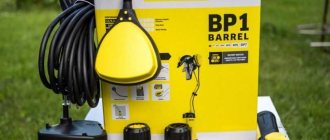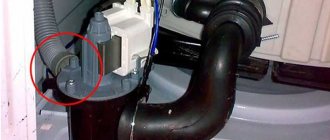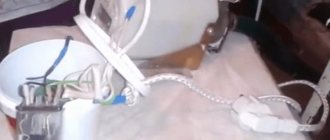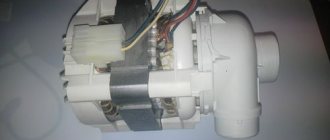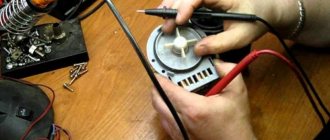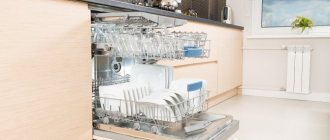When you open the faucet in your home to simply drink water, and a sluggish trickle flows from it, the thought immediately comes to mind of installing a pressure booster pump in the water supply line.
Adequate water pressure in the pipes is the key to the normal life of a person living in a private cottage, country house or high-rise apartment. This is very important for the trouble-free operation of household hydraulic machines and plumbing parts. This is one of the very important conditions for your comfortable living and the durability of the expensive water equipment of your home.
For normal operation of the main models of household hydraulic machines and plumbing units, a water pressure in the pipelines of 2 to 4 bar is sufficient. If you periodically or constantly have a lack of these indicators at the outlet of the intake taps, then you should understand the reasons for this deficiency and, if necessary, install booster pumps for yourself individually or for collective use.
Below we will describe the basic requirements for checking the performance of your water supply system, the criteria for choosing the appropriate equipment, and consider the different types of pumps for increasing water pressure in mains from different manufacturers.
Comparative scale of technical characteristics of water pressure in pumps of various types
Global pump manufacturers use the following units for measuring water pressure for the pressure characteristics of different types of pumps:
For quick approximate household calculations, approximate ratios of these quantities are suitable:
In practice, for the normal operation of household hydraulic equipment with automation, the use of flow valves and the operation of bathrooms, the operation of geysers and boilers, it is enough to maintain the water pressure in the pipelines within 2-4 bar for all major models of household water devices.
Where can I buy?
To find a supplier of pumping equipment, you can safely look on the Internet. Knowing the desired indicators, it is not difficult to choose a brand and model, as well as get advice from professionals. For this purpose, it is better to consider large firms or companies that are official dealers. Moreover, they don’t take money for it. After you decide on the brand and model, you can look for a selling organization with the best price, location, delivery, installation capabilities, warranty and post-warranty service.
The choice of offers is huge: from spontaneous markets to official representative offices of famous brands. It is worth remembering that chasing the best price is not always justified, since the time will come when you will be faced with issues of warranty and post-warranty service.
Let you always have clean and tasty water, and in sufficient quantity. Clean water for you, comfortable living and coziness in your home.
Possible reasons for the lack of water pressure in the mains
The lack of water pressure in your pipelines for high-rise apartments may be due to several reasons:
- Daily fluctuations in water pressure in the water supply due to the frequency of use of the resource by the residents of the house;
- Lack of design capacity of general-use pumping equipment from the service organization;
- Temporary deposits of rust and salts inside the pipeline that clog the body of the water riser:
- Clogged water filters in the water supply connection system:
In such cases, you should interview neighbors on the floor and residents of the upper and lower floors of an apartment building to find out what water pressure usually occurs in their apartments. This way you can identify the local cause of low pressure in your particular case. It will already be possible to make the right decision to eliminate these problems or settle on the option of purchasing a high-pressure water pump individually or for public use, having agreed on this issue with other residents of the entrance (riser) of the high-rise building.
In a private home, these reasons are of a similar type. But there may be various additional reasons for low water pressure in your pipeline:
- Large distance from the main water supply pump;
- Excessive elevation of the structure and location of the flow valves above the pump installation level;
- Inconsistency between the pressure data of the power plant and the specific layout of power and consumable units, etc.
Design specifics
The “wet” pump operates absolutely silently, is reliable in operation, and economical. Due to its low efficiency (up to 50%), it is recommended for installation in a cottage or country house.
A “dry” pump has a high efficiency (about 80%), but is noisy in operation. It is necessary to move units of this type to a separate room with increased sound insulation. These pumps have high power. As a rule, they are used in high-rise buildings, or for water supply to large areas for various purposes.
Types of water pressure boosting pumps in pipelines
In practice, you can increase the pressure in the water artery using 2 well-known types of pumps:
- By inserting a circulation pump with a wet or dry rotor into the water supply line;
- By installing into the main line an additional self-priming power unit or an automatic pumping station based on this type of pump.
Diagrams of approximate connection of pressure booster pumps of various types:
Electric circulation pumps help in cases where it is necessary to increase the water pressure in the pipeline with a stable supply, but low pressure, reaching no more than 1 - 1.5 bar. In multi-storey buildings, using this type of pump it is unlikely that it will be possible to create a sufficiently stable pressure for all residents of the riser, even if you install 2 or more pumps. This option is more suitable for individually increasing water pressure in a separate apartment. This is, so to speak, a “home” option for stabilizing pressure.
For this reason, in apartment buildings with large number of floors, it is better to use a self-priming pump with higher capacity or a pumping station with appropriate automatic water pressure with its own hydraulic accumulator.
With this option, you will not bother yourself with the problems of turning the pump on and off; the automation will do it for you.
When installing any type of pump, it should be taken into account that if there is temporarily no water pressure at all in the taps of a high-rise building on the upper floors, then installing a booster pump will not correct this situation. The pump requires at least a minimum water pressure that meets technical limitations in order to increase it to the desired level.
If you install any booster pump only in your apartment, then keep in mind that it will create a discharge effect in the common pipeline before it. And air will be sucked into this rarefied space. It would be good if the pump was automatically protected from dry running and its motor would not burn out, but it would constantly turn off. In this case, you create an even greater pressure drop in the common water supply pipe. If other residents of your entrance or riser follow your example, this will lead to even more disastrous results with water and real “sanctions” from the water supply organization.
Self-priming pumps are limited by the amount of water rise along the installation height from the water surface to 7-8 meters (maximum 12). You also cannot install a large reservoir for a circular pump with a supply of water in a medium-sized apartment. You will have to negotiate and cooperate with your neighbors to install such a container in the attic of the house.
The most competent and comprehensive solution to these problems may be the installation of a full-fledged automatic station with a self-priming centrifugal pump. The power device must be of high performance. Contain your own hydraulic accumulator of the maximum possible volume and fully automate the water supply process. This station can be connected to the basement collector of the common riser of the general water supply or to an autonomous source. This is the only way to create the required water pressure at the outlet of all taps and not aggravate the situation for the neighbors.
How to choose a surface pump - recommendations and tips
In general, to choose a surface water pump, you need to take into account quite a lot of nuances and subtleties. Let's talk about the main ones.
One of the most important indicators is suction depth . It shows what the maximum depth between the water level and the pump can be so that the latter operates stably and without interruption.
Also, do not forget about performance - it directly depends on power. The performance determines how much water the pump can deliver in a certain time.
The maximum pressure shows the permissible length of all pipes located between the pump and the end consumer (more precisely, a boiler, storage tank or other container where water is stored).
Finally, we must not forget about safety . It is desirable that the pump have protective functions that protect it from overheating and failure. They significantly reduce the likelihood that you will have to take the pump to a repair shop a few weeks after purchase.
Selecting a water pressure booster pump
Circular pumps are divided into 2 groups:
We are accustomed to considering circular pumps only as elements of heating systems. But they have wider applications.
- Household pumps with wet rotor. They are more compact and quieter during operation. They do not require preventive maintenance to lubricate rubbing parts, since this occurs by washing the rotor shaft with water. They are easy and simple to install directly into the water supply pipe using a tie-in and do not require additional fastenings. But this group of pumps has low performance and low pressure indicators. In addition, these units are installed with a horizontal axis of the electric motor rotor.
- Circular pumps with a dry rotor have an asymmetrical housing shape towards the electric motor. They are cooled by a stream of external air from a special impeller. Requires additional fastening to the wall. They have better technical capabilities in terms of pressure and performance. They require regular lubrication of rubbing parts. They create quite a loud noise when working.
Both groups are suitable for cold and hot water, but require constant manual control of the on/off mode.
To save yourself from this, you need to choose a circular pump equipped with a water flow sensor. Then the pump will start only when the supply tap is opened and there is water in the line.
The same effect can be achieved by installing a separate flow sensor on any group of circular pumps. And if the pressure in the system is unstable and there is insufficient water in the water supply, you will need to install an additional pressure switch.
Some popular models of circular pumps from global manufacturers: Grundfos (Grundfos) UPA 15-90:
Circular pumps Jemix W15GR and WP series:
Direct-flow pumps Oasis (Oasis) CNP15/9:
Pressure booster pumps from the Wilo brand, PB and PW series
- Self-priming centrifugal pumps can operate when water pressure increases, either independently or as part of automatic pumping stations.
- Specialized stations for increasing water pressure from main water pipelines of the Gilex VODOMET M brand are used for inserting into the underwater part of individual sources. They have an additional flow-through filter unit for supplying already purified drinking water:
Specially designed pumping units for increasing water pressure from Grundfos: CMBE 3-62, 5-62, 1-44, 1-75, 3-30, 3-93 and others:
Rating of the TOP 15 best pumps for wells 2020-2021
| Place | Name | Price |
| TOP 5 best well pumps by price/quality for 2021 | ||
| 1 | Grundfos SBA 3-45 A | Find out the price |
| 2 | Aquario ASP2-25-100WA (620 W) | Find out the price |
| 3 | DAB DIVERTRON 1200 M (1100 W) | Find out the price |
| 4 | GILEKS Water cannon PROF 55/75 A (900 W) | Find out the price |
| 5 | VORTEX VN-15N (280 W) | Find out the price |
| TOP 5 best inexpensive well pumps | ||
| 1 | PATRIOT VP-10 (300 W) | Find out the price |
| 2 | KARCHER BP 1 Barrel (400 W) | Find out the price |
| 3 | LIVGIDROMASH Malysh BV-0.12-40-U5 10 m (240 W) | Find out the price |
| 4 | UNIPUMP BAVLENETS BV 0.12-40-U5, 40m (245 W) | Find out the price |
| 5 | GILEKS Water cannon PROF 55/35 (460 W) | Find out the price |
| TOP 5 best powerful pumps for wells | ||
| 1 | DAB DIVERTRON 1000M (650W) | Find out the price |
| 2 | Grundfos SBA 3-35 A | Find out the price |
| 3 | GILEKS Water cannon PROF 55/50 A df (600 W) | Find out the price |
| 4 | Aquario ASP2-40-100WA (750 W) | Find out the price |
| 5 | GILEKS Water cannon PROF 55/35 A (460 W) | Find out the price |



